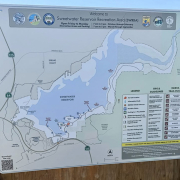New Sweetwater Reservoir Trail Open for Recreation
A brand-new 2.2-mile trail is open along the east side of Sweetwater Reservoir. Originally a maintenance road, the trail has been transformed into a scenic pathway for walking, running, and mountain biking.
Previously accessible only as a maintenance road, the 2.2-mile route has been repurposed into a safe and inviting public trail ideal for walking, running, and mountain biking.
“Sweetwater is committed to increasing public recreation while protecting water quality and preserving the environment and habitats at Sweetwater Reservoir,” said Sweetwater Authority board chairman Manny Delgado. “This new trail and the accompanying improvements are a testament to those continued commitments.”
This enhancement was made possible through a $1.16 million grant awarded to the Urban Corps of San Diego County by the California Conservation Corps, dedicated to trail improvements and habitat restoration. Additional support came from the County of San Diego, through two generous grants to the San Diego Mountain Biking Association.
Trail Provides New Access to Open Space

(L to R) Sweetwater Authority Assistant General Manager Roberto Yano, Otay Water District board member and San Diego County Water Authority board member Mark Robak, and National City Vice Mayor, Sweetwater Authority vice chair and San Diego County Water Authority board member Ditas Yamane at the ribbon cutting for the new Sweetwater Reservoir southern trail. Photo: Susie Murphy, @CVBikeMom63/Instagram for San Diego Mountain Biking Association
Dedicated in September, the new trail connects the Sweetwater Reservoir Recreation Area (SWRRA) with the County of San Diego’s Southern Trail, offering the South Bay community fresh opportunities to explore and enjoy the outdoors. The trail connects to existing paths in the area and was created while preserving native vegetation and sensitive habitats, benefitting local wildlife.
The trail runs parallel to the reservoir’s shoreline east of Bonita and south of Spring Valley. It provides beautiful views of the water and the surrounding open space. It also connects to the San Diego National Wildlife Refuge, a protected area that preserves native plants and wildlife as part of a regional conservation effort.
The trail is designed to be more accessible for beginners and families than some of the more rugged trails in the adjacent Wildlife Refuge to encourage fitness and recreation. By linking with existing paths, the trail also strengthens the region’s recreation network, creating new opportunities for exploration and connectivity.
Along with opening the trail, Sweetwater Authority has taken steps to protect the environment. Crews are restoring nearby habitat by removing invasive weeds, improving drainage, and planting native vegetation. These improvements will make the area healthier, support local wildlife, and reduce wildfire risk.
Trail Preserves Local Environment

South Bay community leaders and members of the public gathered to celebrate the opening of the newest trail at the Sweetwater Authority Recreation Area. Photo: Photo: Susie Murphy, @CVBikeMom63/Instagram for San Diego Mountain Biking Association
The addition of the new trail builds on Sweetwater Reservoir’s long tradition of outdoor recreation, which already includes a popular shoreline fishing program open Friday through Monday. With the new trail, visitors have another way to enjoy the natural beauty of Sweetwater Reservoir while also helping to protect the local environment.
The Sweetwater Reservoir Shared Maintenance Road and Trail officially opened to the public on September 5, 2025. Trail maps, visiting hours, and safety guidelines are available on Sweetwater Authority’s website at www.sweetwater.org.




